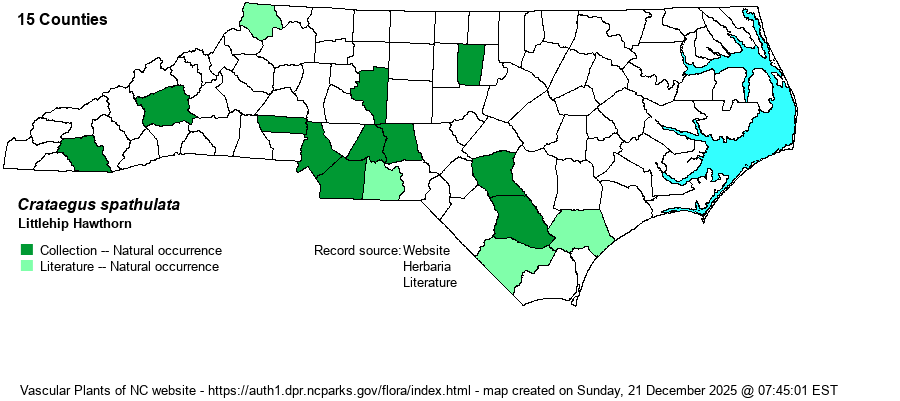| Author | Michaux | |
| Distribution | Occurs in the southwestern Coastal Plain, (mostly) southern Piedmont, and rarely in the southern Mountains (if correct there). Though this is a long-established species, identification is nonetheless tricky, and one wonders about the validity of a few reports, such as for the Mountains. Certainly is native from about Columbus and Cumberland counties on the east to Davidson and Union counties on the west, and to Davidson on the north. Lance's (2014) range map excludes the Mountains of NC.
This is a Southern species ranging from NC west to MO and south to northern FL and central TX.
| |
| Abundance | Rare to uncommon in the southwestern Coastal Plain and southeastern Piedmont counties, but rare to the central Piedmont, and very rare (if correctly identified) in the Mountains. The NCNHP has it listed as a Watch List species and a state rank of S1S2; however, based on the somewhat numerous counties reported, and its moderate range in the state, a less rare state rank of S2 seems more appropriate, even perhaps removal from the Watch List in the near future. | |
| Habitat | This is a species of rich bottomlands, and river and stream banks. It can occur on rich lower slopes and even in rocky upland woods, but essentially where the soil is circumneutral. As such, it has a somewhat narrow distribution in the state, in terms of being found mainly close to or along moderate to large brownwater rivers, as opposed to occurring in smaller swamps, bottomlands, floodplains or creek banks. |
| Phenology | Blooms in April and May, and fruits in September and October. | |
| Identification | This is a small tree, rarely a large shrub, growing to 20-25 feet tall. It has distinctive, patchy-colored bark due to various amounts of flaking off of bark layers. The leaves are quite distinct in that they are very narrowly cuneate, tapering gradually to the stem, but normally with three lobes toward the apex; the teeth toward the tip are generally rounded and not sharp. Several other swamp/bottomland hawthorns have cuneate leaves, such as C. aestivalis, but these typically are not 3-lobed at the apex and are not as narrowly cuneate toward the base. The leaves also are rather small, barely 1.5 inches long. Thorns may be quite scarce along the stems. To see this species in NC, you may need to walk alongside or close to the banks of major rivers such as the Lumber, Cape Fear, and Pee Dee. | |
| Taxonomic Comments | None
| |
| Other Common Name(s) | Surprisingly none
| |
| State Rank | S1S2 [S2] | |
| Global Rank | G5 | |
| State Status | W1 | |
| US Status | | |
| USACE-agcp | FAC link |
| USACE-emp | FAC link |

